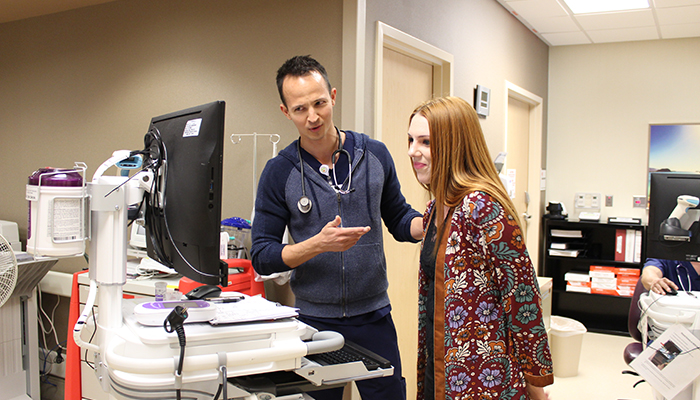By Joseph Stillo, M.D., Ph.D., and Dayle Unger, RN
The use of predictive modeling is growing within the healthcare space. While the acute-care sector has been utilizing the power of big data to predict outcomes for some time, predictive modeling is uncharted territory in the post-acute space. However, with a large database afforded by an electronic medical record system, predictive modeling in the post-acute setting has the potential to effectively couple the clinical status of a patient to evidence- based clinical interventions in order to optimize outcomes.
Predictive models generally leverage big data with the goal of establishing relationships between the patient and population characteristics with some defined outcome. The analytical model is then used to identify the risk of that outcome—positive or negative—with the goal of changing it. In other words, data analysis can signal an impending bad outcome, so clinicians can more readily intervene and potentially prevent it.
Encompass Health, one of the nation’s largest networks of inpatient rehabilitation hospitals and home health and hospice agencies, recently used this approach to develop ReACT, a model which predicts the risk of unplanned acute care transfers from an Encompass Health inpatient rehabilitation hospital.
Derived from more than 80,000 patient records, the ReACT algorithm runs throughout a patient’s stay and categorizes the patient’s level of risk for an acute care transfer. The categorization of a patient as very high risk at any time during the stay triggers an additional clinical assessment leading to possible enhanced monitoring and treatment.
Several factors were key in the development of this predictive model, which is now running in all of our 130 inpatient rehabilitation hospitals. The following are some of the key steps we took to successfully develop ReACT.
- Identify the problem. For Encompass Health, it was acute care transfers. They are costly, but more importantly, they negatively influence patient outcomes as well as patient perceptions and satisfaction with those outcomes.
- Administrative alignment with project goals was vital. Our leadership team as well as our partners in IT quickly embraced the project since it could assist our clinicians in making the best decisions for our patients.
- Early involvement and input from clinical staff was critical. Having clinicians involved as we piloted the model in five Encompass Health hospitals allowed for feedback and afforded the opportunity to make adjustments before deploying ReACT in all our hospitals.
- Partner with health information technology experts. It was important that we leverage our information infrastructure and apply this knowledge of the post-acute healthcare workflow and patient type with a partner like Cerner, a leading supplier of healthcare information technology solutions. Encompass Health’s partnership with Cerner dates back nearly a decade, when we partnered with them to build a proprietary electronic medical record system, “ACE IT”. With Cerner’s predictive modeling experience and skill set of data scientists combined with Encompass Health’s vast database of medical records from its inpatient rehabilitation hospitals, the partnership allowed the most comprehensive team to direct this effort.
- A large dataset is a must for data mining in order to establish statistical relationships between factors. Without the clinical data repository of ACE IT, we would not have been able to aggregate, study and generate a predictive model. Utilizing years of our unique inpatient rehabilitation hospital data allows this to be a targeted model specific to our patient type, that is, the inpatient rehabilitation hospital segment of the post-acute care environment.
- Blending clinical team opinion with statistical expertise was critical. Molding the dataset so it made sense while still maintaining statistical significance was a key factor in clinical feature selection. For ReACT, we narrowed it down to 30 clinical variables and three tiers of risk ranging from low to very high. We then determined thresholds for those risk tiers to achieve a balance of manageable populations within each tier. For example, it was prudent to avoid a threshold that would place most of the patients in the highest risk tier.
As we move forward in developing additional predictive models to improve outcomes and efficiencies in our inpatient rehabilitation hospitals, these key steps serve as a road map to the successful development and deployment of predictive models in the post-acute setting.
Joseph Stillo, M.D., Ph.D., joined Encompass Health (formerly HealthSouth) in 1998 as the medical director for HealthSouth Rehabilitation Hospital of Toms River in New Jersey. He serves on Encompass Health’s Physician Advisory Board. More recently, he transitioned to serve as physician executive to the ACE IT project as well as Encompass Health’s Vice President of Medical Services.
Dayle Unger joined Encompass Health in 1988 as a registered nurse. Over the years, she has served in various roles in the company including director of business development, hospital CEO, and Vice President of Clinical Transformation. She is now serves as Clinical IT Advisor for Encompass Health.
The content of this site is for informational purposes only and should not be taken as professional medical advice. Always seek the advice of your physician or other qualified healthcare provider with any questions you may have regarding any medical conditions or treatments.



